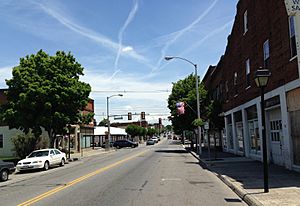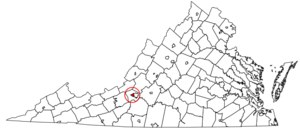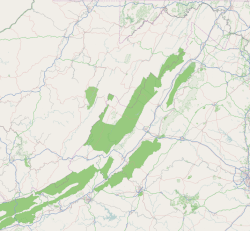Salem, Virginia facts for kids
Quick facts for kids
Salem
|
||
|---|---|---|

Main Street in Salem
|
||
|
||

Salem's location in the Commonwealth of Virginia
|
||
| Country | United States | |
| State | Virginia | |
| County | None (Independent city) | |
| Government | ||
| • Type | Council-Manager | |
| Area | ||
| • Total | 14.62 sq mi (37.88 km2) | |
| • Land | 14.52 sq mi (37.60 km2) | |
| • Water | 0.11 sq mi (0.28 km2) | |
| Elevation | 1,075 ft (358.14 m) | |
| Population
(2020)
|
||
| • Total | 25,346 | |
| • Density | 1,733.7/sq mi (669.11/km2) | |
| Time zone | UTC−5 (EST) | |
| • Summer (DST) | UTC−4 (EDT) | |
| Zip Code |
24153
|
|
| Area code(s) | 540 | |
| FIPS code | 51-70000 | |
| GNIS feature ID | 1498533 | |
| Website | http://www.salemva.gov/ | |
Salem is a city in Virginia, a state in the United States. It is called an independent city because it is not part of any county. In 2020, about 25,346 people lived there. Even though it's independent, Salem is the main town, or county seat, for Roanoke County.
Salem has its own courthouse and sheriff's office. It shares a jail with Roanoke County. Roanoke College is located in Salem. The city is also home to the Salem Red Sox, a professional baseball team.
Contents
History of Salem, Virginia
The area where Salem is today has a long history. Native American tribes lived here as far back as 8,000 years ago. European explorers first came in 1671. They found a village of the Totero tribe nearby. These explorers named the area Totero Town.
Early Settlements and Naming
A fort called Fort Lewis was built west of the town in 1752. It was named after General Andrew Lewis. Salem's Andrew Lewis Middle School is also named after him. Salem started as a small stop for travelers on a major road. This road is now similar to US-11 and Interstate 81.
Salem was officially founded in 1802 and became a town in 1806. No one knows for sure why it was named Salem. A common idea is that it was named after William Bryan. He was an important person who moved from Salem, New Jersey.
Salem During the Civil War
During the American Civil War, the Union Army attacked Salem twice. Salem had its own group of soldiers called the Salem Flying Artillery. People say they fired the last shot for the Confederate side at Appomattox Court House. This happened just before Robert E. Lee surrendered.
Growth and City Status
One of Salem's elementary schools is named after the famous African American scientist G. W. Carver. Before schools were integrated, this building was the high school for African American students in Salem.
Salem grew by adding nearby areas in 1953 and 1960. This made it Virginia's largest town at the time. Salem officially became a city on December 31, 1967. This change helped it avoid being taken over by the larger city of Roanoke. As a city, it became separate from Roanoke County. However, it still serves as the county seat.
Colleges in Salem
Salem has been home to two colleges. In 1847, a school called the Virginia Institute moved to Salem. It became Roanoke College in 1853. This college is in central Salem, near Main Street.
Another college, Roanoke Women's College, also existed. It was later called Elizabeth College. It operated from 1912 to 1922. The college building burned down in 1921 and never reopened. Today, the land where Elizabeth College was is used for dorms and sports fields for Roanoke College.
Sports and Events in Salem
Salem is a big sports town! It is home to the Salem Red Sox. This is a minor league baseball team linked to the Boston Red Sox.
Major Sports Championships
Salem has hosted many important sports events. The Amos Alonzo Stagg Bowl football game was held at Salem Football Stadium for many years. Because of Salem's success with this event, the NCAA also brought other championships here. These include:
- The NCAA Men's Division III Basketball Championship at the Salem Civic Center.
- The NCAA Division III women's volleyball tournament at the Salem Civic Center.
- The NCAA Division II softball tournament at the James I. Moyer Sports Complex.
- The NCAA Division III softball tournament at the James I. Moyer Sports Complex.
In August 2007, the Salem Football Stadium also hosted a special football game. This game is played every year between two teams from Historically Black Colleges and Universities. Salem is known for its friendly atmosphere and great sports facilities.
Salem High School Athletics
Salem High School is also famous for its sports teams. Their football team has won many state championships since 1996. The school's forensics team, which focuses on public speaking and debate, has won many state championships too.
Geography of Salem
Salem is located at 37°17′12″N 80°3′21″W / 37.28667°N 80.05583°W.
The United States Census Bureau says the city covers about 14.5 square miles. Most of this area, about 14.4 square miles, is land. A small part, about 0.1 square miles, is water.
Population of Salem
| Historical population | |||
|---|---|---|---|
| Census | Pop. | %± | |
| 1860 | 612 | — | |
| 1870 | 1,355 | 121.4% | |
| 1880 | 1,759 | 29.8% | |
| 1890 | 3,279 | 86.4% | |
| 1900 | 3,412 | 4.1% | |
| 1910 | 3,849 | 12.8% | |
| 1920 | 4,159 | 8.1% | |
| 1930 | 4,833 | 16.2% | |
| 1940 | 5,737 | 18.7% | |
| 1950 | 6,823 | 18.9% | |
| 1960 | 16,058 | 135.4% | |
| 1970 | 21,982 | 36.9% | |
| 1980 | 23,958 | 9.0% | |
| 1990 | 23,756 | −0.8% | |
| 2000 | 24,747 | 4.2% | |
| 2010 | 24,802 | 0.2% | |
| 2020 | 25,346 | 2.2% | |
| U.S. Decennial Census 1790–1960 1900–1990 1990–2000 2010 2020 |
|||
The population of Salem has grown steadily over the years. In 1860, only 612 people lived there. By 2020, the population had grown to 25,346 people.
Notable People from Salem
Many interesting people have come from Salem, including:
- Mark Byington: A college basketball coach.
- Dennis Haley: A former professional football player.
- John McAfee: A computer programmer and businessman.
- Marcus Parker: A former professional football player.
- Ruth Painter Randall: A writer who wrote biographies.
- Billy Sample: A former professional baseball player and writer.
- David C. Shanks: A U.S. Army major general.
- Leander J. Shaw, Jr.: A former Chief Justice of the Florida Supreme Court.
- Adam Ward: A photojournalist.
Images for kids
See also
 In Spanish: Salem (Virginia) para niños
In Spanish: Salem (Virginia) para niños







